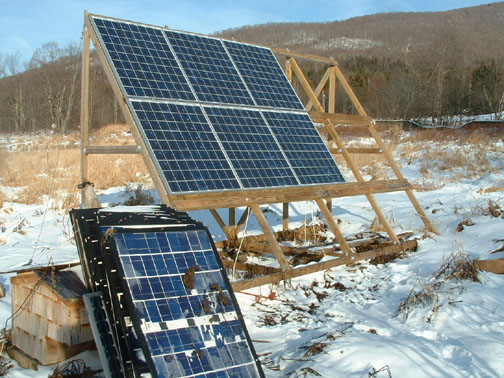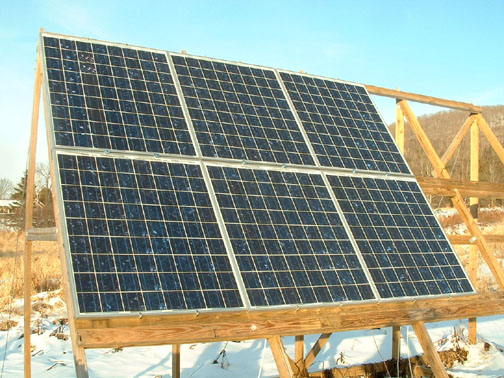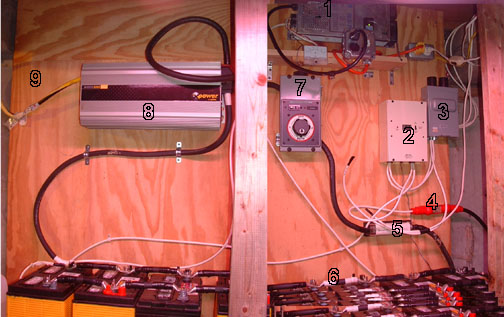I had 12 homemade panels get damaged beyond repair after a horrific wind storm about a month ago. I used the ebay cells that were selling awhile back. These were super thin "Evergreen" type cells, and they couldn't withstand the shaking they got with gusts of up to 80mph all day.
I had a sick feeling all that day as I watched my panels die a horrible death. Then I thought about all the poor people in Hurricane Katrina and how their insurance companies refused to pay because their damage was not wind damage. That planted a seed in my mind to try and submit a claim on my homeowner's insurance for my wind damage. I didn't think I would get anything, but I was wrong. My insurance company was extremely helpful, and they paid the complete replacement costs minus my deductible. Thank goodness for homeowner's insurance.
Today my new system generated its first significant power, and I had to take a couple of pictures to show off my new babies. The first shot shows the 6 new Matrix Photowatt 165 watt panels mounted on the frame. In the foreground are the old panels, or what's left of them, showing how the cells shattered.

Here is a closer image of the Photowatts. They are configured as 24v panels. They are paired together in series and two separate lines of about 80v open circuit carry the electricity of four panels and of the remaining two panels into my cellar where

all of the control circuitry and the battery bank are located.

Items in the picture above are 1. Iota Charger, controlled by my Grid Charger Voltage Switch with an analog ammeter; 2. BZ MPPT500 Controller (the sustem will ultimately utilize two of these controllers);3. Solar panel fuses and disconnect; 4. Controller output fuse; 5. Battery output fuse; 6. Battery array (eight Walmart special 125 amp-hour deep cycle batteries; 7. Battery DC output disconnect switch; 8. Xantrex 3500 watt modified sine inverter; 9. 120vac out (goes to a distribution panel located elsewhere)
I have been running a separate string of outlets in my house so in places I have two outlets side by side. One is grid power; the other is solar power. At present this system powers the electronic ignition and blowers on my two propane heaters, the propane tankless water heater, the ignition and oven glow tube on my propane range, the refrigerator, a couple lights in my living room, and an outlet on my porch.
This is a very hefty load for the panels. They are able to keep up when the sun is shining, but need help when we get extended periods of cloudy weather (which we do for weeks on end in spring and fall). That's where the Iota charger comes in handy. My grid power voltage switch turns the Iota charger on when battery voltage falls to 12.1 volts, and it runs for 1, 2, or 3 hours depending on a jumper setting on the board. The Iota is capable of delivering the current necessary for powering all of my load so I don't have to worry about under charged batteries or disconnecting loads when the sun doesn't shine. The upshot is, when the sun shines I run my load for free. When it doesn't I pay the utility company for the power. It's a little like a grid tie system in reverse. One benefit over a true grid-tie system is when the grid goes down, I still have power for as long as the batteries hold out. So if I should lose my power, I will have heat and hot water, kitchen facilities, and a light in my livingroom to read by. What more could I want?